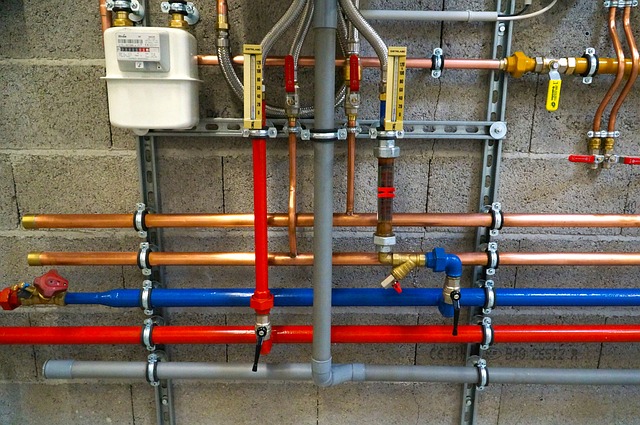Optimal water pressure (40-80 PSI) and flow are crucial for the efficient operation of household plumbing systems, ensuring safety and preventing issues like leaks and clogs. Professional plumbers use pressure gauges and flow meters to measure and maintain these parameters, which are key to both performance and longevity of the plumbing infrastructure. Regular maintenance by a plumber can detect problems early, extend the system's life, and enhance convenience and functionality in the home. Homeowners should schedule annual plumbing inspections to ensure their systems operate within recommended standards, preventing potential water damage and fixture failure. Beyond regular checks, homeowners can perform basic upkeep on fixtures like faucets and showerheads, ensuring aerators are clear for optimal flow. Always consult a professional plumber for personalized advice and service to maintain your plumbing system's peak performance.
When it comes to the functionality of your home’s plumbing system, water pressure and flow are critical components. Ensuring these elements perform optimally not only enhances daily comfort but also safeguards against potential leaks and costly repairs. This article delves into the intricacies of testing water pressure and flow within a residential plumbing system, highlighting the importance of professional plumber expertise and the tools they employ to maintain peak performance. From understanding the basics to performing DIY checks at home, this guide provides comprehensive insights and practical solutions for anyone looking to ensure their water system runs smoothly.
- Understanding Water Pressure and Flow in Home Plumbing Systems
- The Role of Plumbers in Testing Water Pressure and Flow
- Tools and Methods for Testing Water Pressure and Flow at Home
- Common Issues Affecting Water Pressure and Flow Resolved by Professional Plumbers
- How to Maintain Optimal Water Pressure and Flow with Routine Plumbing Maintenance
Understanding Water Pressure and Flow in Home Plumbing Systems

Understanding water pressure and flow within a home plumbing system is crucial for maintaining efficient and safe water usage. Water pressure refers to the force with which water moves through pipes, measured in pounds per square inch (PSI). An optimal pressure range, typically between 40 to 80 PSI, ensures that appliances like showerheads and faucets function properly without wasting water or causing leaks. A plumber can assess your system’s water pressure using specialized tools, such as a pressure gauge, to ensure it aligns with recommended standards. Proper water pressure is essential for the effective operation of all fixtures and prevents potential issues like burst pipes due to excess pressure or inadequate water flow that could lead to clogs and backups.
Flow, on the other hand, pertains to the volume of water traveling through the plumbing system over a given period. Adequate flow is necessary for all water-using appliances to perform as intended. A plumber can inspect your home’s water flow by checking the speed at which water exits faucets and fixtures. If the flow rate is low, it may indicate sediment buildup or a partial blockage in the pipes. Regular maintenance by a professional plumber can help to keep water flowing smoothly throughout the entire system, preventing disruptions and ensuring that every tap delivers the expected volume of water when needed. This not only enhances convenience for the homeowner but also contributes to the longevity of the plumbing infrastructure.
The Role of Plumbers in Testing Water Pressure and Flow

Plumbers play a critical role in ensuring that water pressure and flow within residential, commercial, and industrial plumbing systems are optimal for functionality and safety. Their expertise is indispensable when it comes to diagnosing issues related to water supply. A plumber will utilize specialized tools and equipment to measure the water pressure at various points throughout the system. This process involves connecting a pressure gauge to the main water line or to specific fixtures, allowing the plumber to assess whether the pressure meets the standards set by local regulations or the property’s requirements.
Furthermore, plumbers are trained to evaluate the flow rate of water through pipes and fittings. They do this by using flow meters or conducting flow tests, which can reveal potential problems such as leaks or clogs that might be affecting the system’s performance. A consistent and adequate flow is essential for various applications, from household uses to industrial processes. Plumbers ensure that water flows smoothly without interruption, preventing wastage and ensuring that all water-dependent systems operate efficiently. Their ability to accurately test and maintain water pressure and flow is a cornerstone of building infrastructure that functions as intended and protects the health and well-being of residents and users.
Tools and Methods for Testing Water Pressure and Flow at Home

When assessing the water pressure and flow within a residential plumbing system, homeowners and professional plumbers employ various tools and methods to ensure the system functions optimally. A fundamental device for measuring water pressure is the pressure gauge, which can be attached to any faucet or a specific pressure test valve. This tool provides a precise reading of the incoming mains pressure, allowing for comparison against recommended levels set by local regulations or standards. To test flow rate, a flow meter or a simple gallon bucket and stopwatch can be used; the latter involves timing how long it takes to fill the bucket to determine the gallons per minute (GPM) or liters per minute (LPM). These measurements are crucial for identifying potential issues like low pressure, which could indicate a leak or blockage in the pipes, or high pressure, which might cause wear and tear over time.
For a comprehensive evaluation of the entire plumbing system, a plumber may use a combination of tools. A pressure regulator testing kit can be employed to check if the pressure regulator is functioning correctly by measuring both incoming and outgoing pressure. Additionally, flow rate tests can be performed at various fixtures throughout the house, such as sinks, showers, and toilets, to ensure that each outlet receives an adequate supply of water. In instances where a visual inspection is necessary, a plumber might use a camera system to inspect pipes for blockages or corrosion, which can also affect water pressure and flow. These diagnostic methods are essential for maintaining the integrity and efficiency of a home’s plumbing system, ensuring that it delivers clean, safe water when needed.
Common Issues Affecting Water Pressure and Flow Resolved by Professional Plumbers

Water pressure and flow issues are common in residential and commercial plumbing systems, often necessitating the expertise of professional plumbers to resolve. These problems can arise from a variety of sources, including aged or corroded pipes, which may close off partially due to mineral deposits or rust buildup, affecting both water pressure and flow rates. Low water pressure can also be attributed to issues within the home’s internal plumbing, such as undersized or worn-out pipes, leaks in the system, or incorrectly sized water service lines leading into the property. On the other hand, fluctuating or inconsistent water pressure might indicate a problem with the municipality’s main line or the pressure-reducing valve installed on the property’s side.
Professional plumbers are skilled at diagnosing and addressing these issues. They use specialized tools like pressure gauges to measure water flow and pressure accurately, pinpointing exact locations where problems may exist. A licensed plumber can effectively deal with blocked or collapsed pipes by employing techniques such as hydro-jetting to clear blockages or pipe relining to repair damaged sections without the need for extensive excavation. Additionally, they can recalibrate pressure-reducing valves to achieve the desired water pressure and ensure that all fixtures are receiving adequate flow. By addressing the root causes of water pressure and flow issues, professional plumbers not only enhance the functionality of the plumbing system but also contribute to water conservation and prevent potential water damage in the home or business establishment.
How to Maintain Optimal Water Pressure and Flow with Routine Plumbing Maintenance

Maintaining optimal water pressure and flow in your plumbing system is crucial for both the efficiency of your fixtures and the overall safety within your home or business. To ensure these conditions are met, regular plumbing maintenance is essential. Homeowners should engage the services of a professional plumber to conduct annual inspections. These checks can identify potential issues such as corroded pipes, improperly sized pipes, or malfunctioning pressure-reducing valves. A plumber will also verify that the water pressure is within the recommended range for your area, which typically falls between 40 and 85 pounds per square inch (psi). Excessive pressure can lead to leaks, burst pipes, and damaged fixtures, while too little pressure can result in poor water flow and inefficient use of water.
In addition to professional maintenance, there are several proactive steps you can take. Regularly cleaning or replacing washers on faucets and showerheads can prevent drips and ensure a consistent water flow. Similarly, checking and clearing any debris or blockages from the aerators can maintain the spray quality of your fixtures. It’s also wise to monitor your water meter to detect any unaccounted-for leaks that may be affecting your system’s pressure and flow. By combining professional plumbing services with attentive home maintenance, you can keep your water pressure and flow at optimal levels, thereby extending the life of your plumbing system and avoiding costly repairs down the line. A plumber can guide you through these processes and offer tailored advice for your specific plumbing needs.
In conclusion, maintaining optimal water pressure and flow within a home plumbing system is not only a comfort issue but also an essential aspect of preventing potential plumbing problems. A plumber’s expertise in testing these parameters using various tools and methods can provide valuable insights into the health of your plumbing infrastructure. Regular checks and maintenance can catch issues before they escalate, ensuring that your home’s water pressure and flow remain consistent and reliable. By understanding the importance of these tests and adhering to a routine maintenance schedule, homeowners can safeguard their system against performance degradation and costly repairs. The knowledge imparted by professional plumbers equips you with the power to maintain efficient water use and contribute to your home’s overall safety and comfort.
